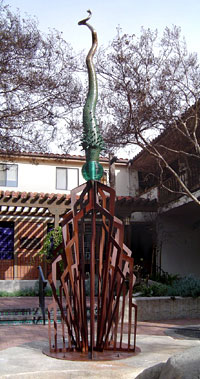Transcendence Through Copper
 Bronze sculpture by Chris Lee
Bronze sculpture by Chris LeePhotograph courtesy of Chris Lee
Copper and its alloys have played an important role in the sculpture of San Diego artist Christopher Lee from his earliest days. In 1980, while still a graduate art student at California State University San Diego, the school commissioned him to create Reflective Disc, an elegant chevron-like form constructed equally of brushed brass and laminated plate glass.
In 1984, Lee produced Nebular Hypothesis. Consisting predominantly of copper, the large multiple element sculpture was created specifically for the two-story lobby of a newly completed bank building in downtown San Diego. Suspended from the ceiling of the lobby at its greatest height, the work's largest element consists of a long copper spiral that the artist cut from a quarter inch copper plate that he stretched by pulling on it with a forklift and finishing its surface with a sanding disk. At its highest end, the spiral embraces a large oxidized steel sphere then it descends to support a cone of laminated glass hovering over a pyramid formed of the same granite as the lobby's floor. Reminiscent of a Galileo-like representation of the energy of the heavens, the work reflects the artist's interest in engaging with the physical realities of the universe that surrounds him, and also something of its mysteries.
The copper elements that play a major role in works like Nebular Hypothesis take on a far less apparent role and serve as subtle enhancements in Lee's well recognized works in which glass is the prominent material. His Spiral Tetrahedrons, for example, consists of a large number of plate glass disks layered one atop the other to form, along with the steel base, the sculpture's overall shape. While the artist's primary interest focuses on the effects of light emerging from the edges of the glass, he often inserts thin veneers of polished copper or brass at regular intervals between the glass disks to introduce barely discernable hints of warm color into the glinting, shimmering exterior of these works. Often, Lee will finish pieces of this type by capping them with a geometric structure formed of the same copper or brass he used within their glass body. Created in sizes ranging from tabletop pieces to outdoor monuments, sculptures of this general type are among the best known of Lee's body of work and are seen in public and private spaces across the country.
The range of Lee's body of work is apparent in The Focus. The sculpture consists of an eight foot burnished aluminum cone which supports a laminated glass sphere and a granite disk that serve as a base for a tree wrapped from its base to its branches in polished and coated copper leaf. Lee created the piece specifically for its location at the center of the glass enclosed, three story entry rotunda of a Kaiser-Permanente administrative facility in Anaheim, California. Sunlight enters the space, captured by numerous small prisms the artist has suspended at the ends of the copper tree's branches. They generate dozens of constantly changing rainbow patterns which dance slowly across the walls and floor of the enclosing rotunda and give the space an aura of delight and serenity that serves to ease the anxieties and pressures that inevitably surround workers and staff involved in healthcare. In this, The Focus reflects more than Lee's ability to relate physical form to physical context. It also reveals his embrace of the challenge to produce an art that can be useful in achieving important purposes; in this case, by creating a subtle and supportive environment for the care givers who daily tend to the sick and the suffering.
"For as long as I've been making art, copper has been one of my favorite materials," Lee says. "It's not just a metal, it's an element, about as basic as you can get, and it's been part of human experience for millennia. You can treat it so many different ways. You can beat it, you can knead it, you can bend it, you can stretch it, you can change its color. You can solder it, weld it, and melt it. Whatever you do, it's still copper, with a natural beauty all its own. It adapts to its environment and complements a lot of other materials in its color, its expansion and contraction properties, and its oxidation properties. You can mix it with other metals and wind up with something altogether different. As a sculptor, as an artist, my palette would not be complete without it."
Also in this Issue:
- An Inside Look at Polich Tallix Fine Art Foundry
- Carol B. Saylor: In Her Mind's Eye
- Syed Ahmad: Capturing Fluid Movement in Glass on Copper
- Transcendence Through Copper
- MAD Museum Exhibits Elegant Armor: The Art of Jewelry
